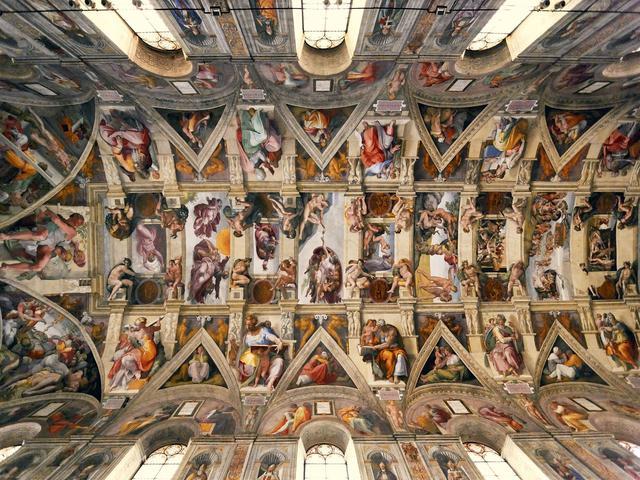Michelangelo's Vault (1508-12)

Michelangelo's Vault, also known as the Sistine Chapel ceiling, is one of the most iconic and breathtaking works of art in the world. Commissioned by Pope Julius II in the early 16th century, this masterpiece took Michelangelo four years to complete, from 1508 to 1512. The project was a monumental undertaking, as Michelangelo had to overcome numerous challenges and obstacles in order to bring his vision to life. The result is a stunning fresco that covers approximately 1000 square meters of the chapel's ceiling, featuring over 800 figures and intricate details that showcase Michelangelo's unparalleled skill and creativity.
The Sistine Chapel ceiling is divided into various sections, each depicting different scenes from the Bible. At the center of the vault, Michelangelo painted the Story of Genesis, which includes iconic images such as the Creation of Light and the Drunkenness of Noah. Surrounding these central scenes are Prophets and Sibyls, representing the convergence of Christian, Greco-Roman, and Jewish cultures. The figures are depicted in a dynamic and expressive manner, with each character exuding a sense of power and emotion that captivates viewers and draws them into the narrative unfolding before their eyes.
One of the most striking aspects of Michelangelo's Vault is the use of perspective and composition to create a sense of depth and movement within the artwork. The figures are arranged in such a way that they appear to be interacting with one another, engaging in dialogue or action that adds a sense of drama and vitality to the scenes. The architectural elements, such as columns, balusters, and cornices, frame the figures and create a sense of structure and balance that enhances the overall composition of the fresco.
As visitors gaze up at the Sistine Chapel ceiling, they are transported into a world of beauty, symbolism, and spiritual significance. The intricate details and vibrant colors of the fresco come to life under the soft glow of natural light that filters through the chapel's windows. Each brushstroke and line drawn by Michelangelo tells a story, conveys an emotion, and invites contemplation and reflection on the divine mysteries and wonders of creation.
Michelangelo's Vault stands as a testament to the artist's genius and creativity, showcasing his mastery of the human form, his understanding of anatomy and movement, and his ability to convey complex narratives through visual storytelling. The fresco is a timeless masterpiece that continues to inspire and awe visitors from around the world, drawing them into its rich tapestry of images and themes that speak to the enduring power of art and faith. As visitors stand in the presence of Michelangelo's Vault, they are reminded of the transcendent beauty and spiritual significance of art, and the enduring legacy of one of the greatest artists in history.
© ChatGPT 3.5
*The painting took three to four years to complete.
*In 1990, Dr. Frank Lynn Meshberger published in the Journal of the American Medical Association that the figures and shadows represented behind the figure of God look like an accurate representation of the human brain including the frontal lobe, optic chiasm, pituitary gland and cerebellum.
*There is another theory that indicates that the red cloak around God resembles the shape of a human uterus and that the green cloth hanging from it could be a recently cut umbilical cord.
*Miguel Ángel built his own scaffolding so he could paint standing up, which consisted of a platform of wooden boards held on supports hooked into holes in the walls, above the windows.
*The artist could have been inspired by the medieval hymn Veni Creator Spiritus, in which the finger of the right paternal hand is asked to give the faithful love and heart.